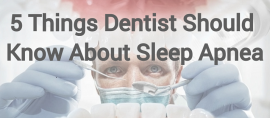
5 Things Dentists Should Know About Sleep Apnea
Obstructive Sleep Apnea is a dangerous disease that takes a serious toll the body over a long period of time with a variety of health complications that include but are not limited to hypertension, stroke, heart disease, and diabetes. The disease is particularly destructive because sleep is an essential part of anyone’s health, influencing hormone levels, metabolism, and cognitive functioning. Unfortunately, the more visible signs of the disease, such as snoring and daytime sleepiness, are commonly perceived as non-threatening. This leaves many to ignore the more serious aspects of the condition to accelerate over time into something potentially life-threatening.
Fortunately, dental professionals are at the front of the line to spot symptoms and treat the condition.
- You can spot symptoms with a routine examination
There are a variety of Obstructive Sleep Apnea symptoms that a dentist and/or Hygienist can identify with a simple look into the airway during a routine examination. Common “red flags” for apnea and/or obstructed airway, that are found during a routine dental visit, are as follows:
- a large/long uvula
- an oversized and “scalloped” tongue
- large tonsils
- signs of bruxism
- Acid Reflux (G.E.R.D.)
You may want to ask your patients about their sleep history if you observe any of these tell-tale signs of the condition. This can easily be done with a few extra questions on screening forms or during a patient history update.
- It’s Underdiagnosed
It’s estimated that around 80% of sleep apnea cases go undiagnosed. Many patients find themselves treating visible symptoms, sleep aids for daytime sleepiness and Medication for High Blood Pressure, before considering a sleep test. This leads to a tragically high mortality rate for those afflicted with heart disease or stroke, as the condition worsens quietly over time.
- It’s Potentially Life-Threatening
Aside from the general decrease in quality of life for these patients, there is absolutely the risk of death from multiple health issues if the condition is left untreated over a period of time. We know that OSA patients are at a particular risk for passing due to:
- OSA causes one to stop breathing multiple times per night which causes blood oxygen levels to go down, causing one’s heart rhythm to flutter. This is a heart complication that occurs at the time of sudden cardiac death.
- OSA causes low oxygen levels and high blood pressure, both can increase the risk of future stroke if left untreated.
Research has shown that patients with obstructive sleep apnea are more likely to experience sudden cardiac arrest between the early hours of 12am-6am. (1)
Another factor worth considering is how the cognitive impairment that sleep apnea causes puts people in danger with everyday task. In fact, The National Highway Traffic Safety Administration estimates that drowsy driving was responsible for 72,000 crashes, 44,000 injuries, and 800 deaths in 2013.
4) Dentists Can Provide OSA Therapy Via Custom Oral Appliances.
For many, over the counter snoring solutions such as chin straps and snoring guards may seem appealing due to their cheaper cost and their ability to treat snoring on some level. These OTC solutions can actually cause more harm than good and have not been proven to effectively treat OSA. It is always recommended to have a trained Dentist overseeing the oral appliance treatment process. Dentists are able to measure effectiveness, titrate the appliance and help manage morning occlusal techniques. Oral Appliance Therapy is an effective and non-invasive treatment for those with Mild-Moderate OSA and for those who cannot tolerate or refuse to use CPAP.
It’s worth noting that ONLY dentists can provide a custom oral appliance that can open the airway with vertical and/or forward positioning. There are oral appliances that can treat OSA and bruxism as well.
5) Men, Women, and Children all Present Symptoms Differently
Women and children present certain symptoms of sleep apnea that, unfortunately, leads to both groups being underdiagnosed and misdiagnosed regularly (even more so than the typical demographic of older males that suffer from the condition).
As far as statistics go, men are around twice as likely as women to have sleep apnea, and it’s estimated that up to 10% of children have the condition.
- Men tend to be able to fall asleep anywhere and anytime, frequent trips to the bathroom at night, general fatigue and extremely loud snoring.
- Women are more likely to present symptoms of insomnia, anxiety, depression and daytime sleepiness. Women have been known to benefit from more deep sleep than men and their circadian cycles usually run shorter than men’s. A UCLA study from 2013 found that women with apnea are more affected in the areas of the brain that regulate decision-making and moods.
- Children tend to present symptoms with mouth breathing, snoring, enlarged tonsils and adenoids, night sweats and bed-wetting. Children with untreated OSA have also displayed difficulty with concentration, poor attention spans and behavioral problems causing poor performance at school. Sadly, studies have suggested that as many as 25% of children diagnosed with some form of attention-deficit hyperactivity disorder may actually have symptoms of obstructive sleep apnea.
As dental professionals, it’s important to look beyond the teeth when examining patients in any situation, and OSA is no exception. You can read more about how OSA affect women and children on our blog.
Conclusion
The airway is a vulnerable and important piece of anatomy, essential to getting proper oxygen levels to your body and brain. To be properly examined, it must be observed and understood in relation to other body systems, including the territory of dental professionals.
The first step is recognizing that there’s an issue. As dentists, you can do so much to help your patients suffering from a serious health defect that may not have been on your radar. Let’s look past the teeth, into the airway and save lives – Giving patients something to really smile about: being alive and well rested.

